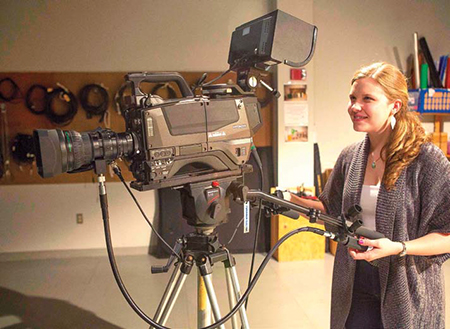Hitachi’s Z-HD6000 HDTV Production Camera

A TV/film student tries out the Hitachi Z-HD6000. Studio-configuration cameras have advanced technologically a great deal in the last few years, and Hitachi is a strong contender in this area. The company’s Z-HD6000 HDTV production camera leads Hitachi’s arsenal in the 2K realm.
FEATURES
Having reviewed Hitachi’s Z-HD5000 a few years ago, I thought that the Z-HD6000 would be a slight upgrade, but this wasn’t the case. It features three 2/3-inch 1920 x 1080 MOS chips for really sharp imaging, a Fujinon F1.8 8.5 to 163 mm zoom lens ahead of these and a stunningly clear VFL90HD nine-inch 1280 x 768 16:9 color viewfinder. All in all, it’s quite an intimidating package.
The right side of the camera as seen from behind the unit also sports HD-SDI and monitor return outputs, as well as a BNC teleprompter port.
The camera’s studio control kit contains a pedestal/tripod arm mountable focus and zoom adjustment for the left and right arms. The CA-HF1000 optical fiber adapter allows digital transmission of the signal bidirectionally, along with two intercom connections, DC input power, HD-SDI output and dual XLR audio inputs.
The camera control unit (CCU) sent with the camera I evaluated was Hitachi’s CUHD500, which remotely allows painting and exposure control of the camera. Its outputs are standard definition, as well as HD-SDI and these include embedded digital audio. There are also component outputs in case you’re using the unit with a switcher that might not be totally HD-ready.
I also received Hitachi’s RU-1000VR, a smaller handheld panel that allows easy adjustment of a number of camera functions, including iris, pedestal and color controls.
The Hitachi camera package is complete and fits in well in any TV studio.
IN USE
Once the Hitachi package was set up in our studio and attached to our control room switcher, my first test was to determine the camera’s ability to shoot in low light as well as in a brightly lit environment.
I involved my cinematography class students in the testing, having them light a scene where table candlelight provided the illumination. Before starting, I asked the class what they thought the outcome would be. Not one student believed that a studio camera could shoot properly in such low light—our current studio cameras could not.
However, such low illumination would stretch any camera’s low light capabilities. We did augment the candle’s flame with a 250 Watt incandescent fixture, but we still had very little light to work with (10 footcandles). Using the camera’s remote panel, we did color balance, adding only a bit of blue to the gammas with the paint function.
The class and I were amazed at the resulting image. The shot looked as if it were shot on film, with deep crisp blacks in the shadow areas and very little noise. I doubt if any CCD camera could compete with this MOS imaging in such low light levels. (With only 10 footcandles of illumination, we were still shooting at f3.5.)
Proof is in the final result and the Hitachi excelled all expectations in low light. We still had the option of upping the gain, but the Z-HD6000’s recorded image looked fantastic without this addition.
Next we tried an experiment with much higher key lighting (350 footcandles) with an f8 lens opening. Again, the images were crystal clear.
The three MOS sensors provide a pristine image and the camera’s high resolution monitor displays that sharpness very accurately.
Zooming in to a close-up shot, we had no need to adjust anything in terms of skin or color detail. Although this is not a comparison with our older studio cameras let’s just say the difference between them and the Hitachi being evaluated could not have been more drastic.
As there’s only a consumer wall monitor in our studio, the 1080p control room monitor best represented the camera’s true output, but it was somewhat amusing to have the entire class “ooh and aah” over the images on the camera’s nine-inch monitor, rather than have them march into the control room one at a time to clearly see the actual output in its true glory. (In my 10 years of teaching this class, this was the first time I’d ever had to inform students that the class had been over for 10 minutes and to ask them to stop looking at the camera’s playback so that the next class could enter the studio.)
While a new camera in the studio always garners a little excitement, showing its range and flexibility in lighting, remote operation, fiber-optic technology, intercom access directly through the camera—along with such image sharpness in a studio camera— all combined to create quite a stir among the students.
The only drawback to this camera may be its price. But the old adage still applies in that you get what you pay for. This new camera allowed us (for the brief period we had it) to broadcast our regular news program in 1080i on our cable channel and dozens of viewers let us know they noticed the drastic difference.
SUMMARY
The Hitachi Z-HD6000 is a high-end studio configuration camera that performs extremely well in low light, has remote capabilities, uses fiber-optic technology, and has pristine image quality. As such it’s a perfect upgrade for older studios.
Chuck Gloman is an associate professor and chair of the TV/film department at DeSales University. He may be contacted atchuck.gloman@desales.edu.
FAST FACTS
APPLICATION
Studio HD video capture, especially in low light conditions
KEY FEATURES
High-quality 1080i technology, 2/3-inch MOS sensors, remote paint and iris controls, fiber-optic technology
PRICE
As tested (complete Z-HD6000 studio camera package), $37,500 MSRP
CONTACT
Hitachi Kokusai Electric
516-921-7200
www.hitachikokusai.us
Get the TV Tech Newsletter
The professional video industry's #1 source for news, trends and product and tech information. Sign up below.
Chuck Gloman is Associate Professor with the TV/Film Department at DeSales University.

